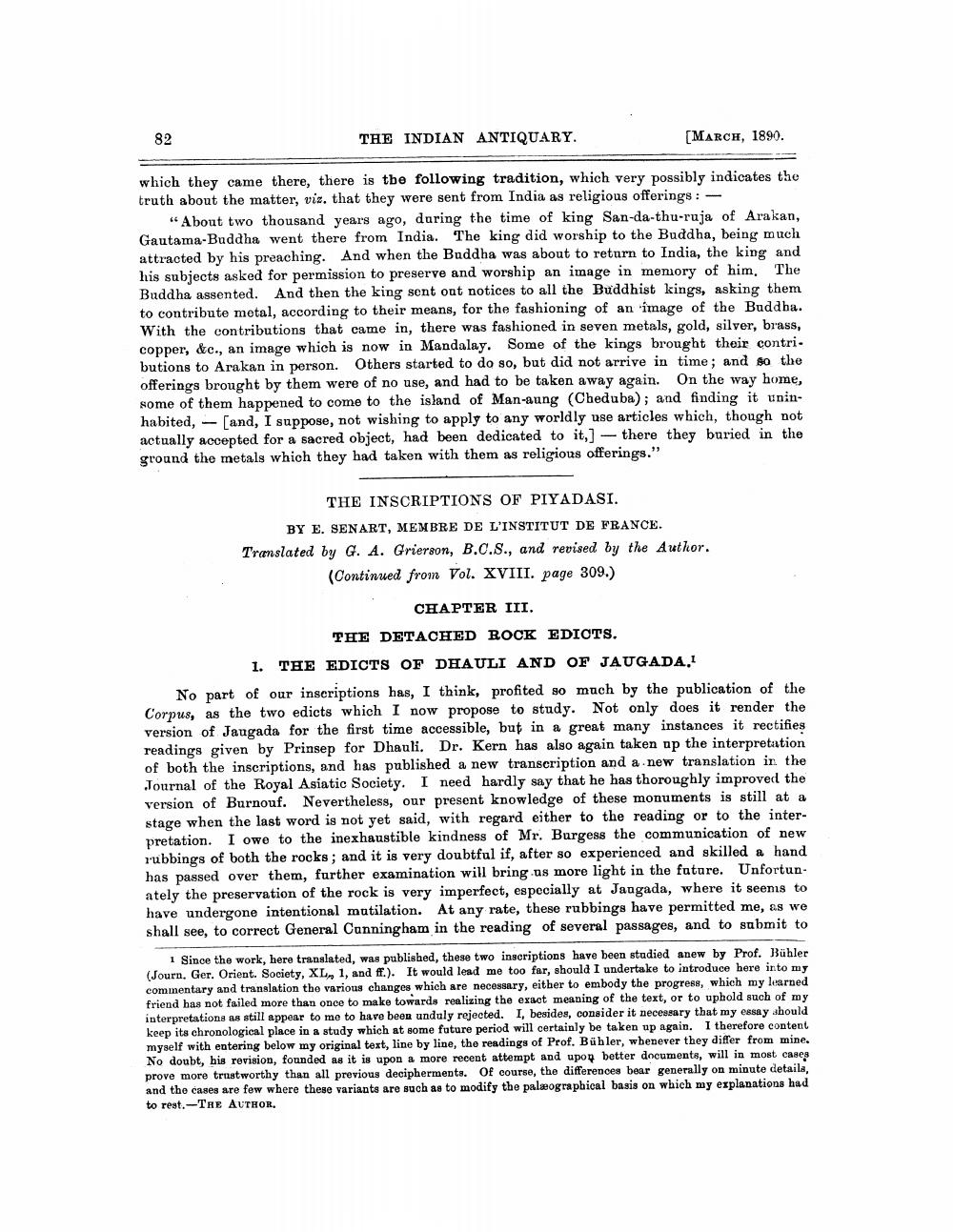________________
82
THE INDIAN ANTIQUARY.
[MARCH, 1890.
which they came there, there is the following tradition, which very possibly indicates the truth about the matter, viz. that they were sent from India as religious offerings : -
"About two thousand years ago, during the time of king San-da-thu-raja of Arakan, Gautama Buddha went there from India. The king did worship to the Buddha, being much attracted by his preaching. And when the Buddha was about to return to India, the king and his subjects asked for permission to preserve and worship an image in memory of him. The Buddha assented. And then the king sent out notices to all the Buddhist kings, asking them to contribute metal, according to their means, for the fashioning of an image of the Buddha. With the contributions that came in, there was fashioned in seven metals, gold, silver, brass, copper, &c., an image which is now in Mandalay. Some of the kings brought their contri. butions to Arakan in person. Others started to do so, but did not arrive in time, and so the offerings brought by them were of no use, and had to be taken away again. On the way home, some of them happened to come to the island of Man-aung (Cheduba); and finding it uninhabited, - [and, I suppose, not wishing to apply to any worldly use articles which, though not actually accepted for a sacred object, had been dedicated to it,] - there they buried in the ground the metals which they had taken with them as religious offerings."
THE INSCRIPTIONS OF PIYADASI. BY E. SENART, MEMBRE DE L'INSTITUT DE FRANCE. Translated by G. A. Grierson, B.C.S., and revised by the Author.
(Continued from Vol. XVIII. page 309.)
CHAPTER III. THE DETACHED ROCK EDICTS. 1. THE EDICTS OF DHAULI AND OF JAUGADA, No part of our inscriptions has, I think, profited so much by the publication of the Corpus, as the two edicts which I now propose to study. Not only does it render the version of Jangada for the first time accessible, but in a great many instances it rectifies readings given by Prinsep for Dhauli. Dr. Kern has also again taken up the interpretation of both the inscriptions, and has published a new transcription and a new translation in the Journal of the Royal Asiatic Society. I need hardly say that he has thoroughly improved the version of Burnouf. Nevertheless, our present knowledge of these monuments is still at a stage when the last word is not yet said, with regard either to the reading or to the interpretation. I owe to the inexhaustible kindness of Mr. Burgess the communication of new rubbings of both the rocks; and it is very doubtful if, after so experienced and skilled a hand has passed over them, further examination will bring us more light in the future. Unfortunately the preservation of the rock is very imperfect, especially at Jaagada, where it seems to have undergone intentional mutilation. At any rate, these rubbings have permitted me, as we shall see, to correct General Cunningham in the reading of several passages, and to submit to
1 Since the work, here translated, was published, these two inscriptions have been studied anew by Prof. Bühler (Journ. Ger. Orient. Society, XL, 1, and ff.). It would lead me too far, should I undertake to introduce here into my commentary and translation the various changes which are necessary, either to embody the progress, which my learned friend has not failed more than once to make towards realizing the exact meaning of the text, or to uphold such of my interpretations as still appear to me to have been unduly rejected. I, besides, consider it necessary that my essay should keep its chronological place in a study which at some future period will certainly be taken up again. I therefore content myself with entering below my original text, line by line, the readings of Prof. Bühler, whenever they differ from mine. No doubt, his revision, founded as it is upon a more recent attempt and upou better documents, will in most case prove more trustworthy than all previous deciphermente. Of course, the differences bear generally on minute details, and the cases are few where these variants are such as to modify the palæographical basis on which my explanations had to rest.-TRE AUTHOR.




